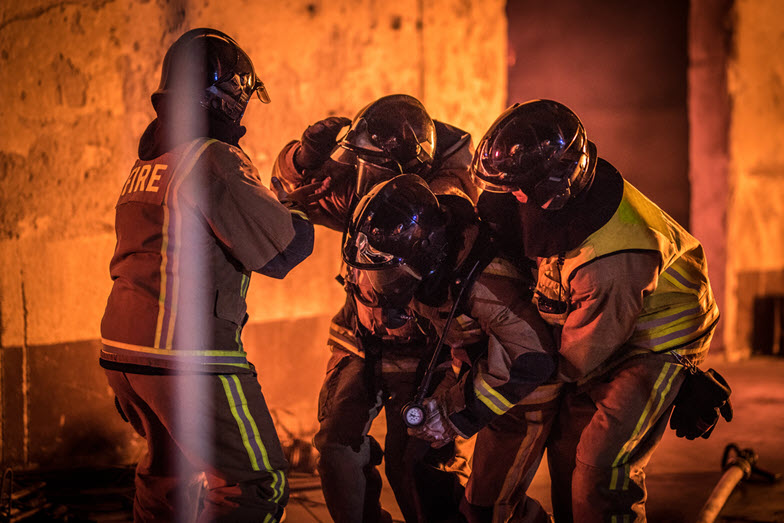
It is no secret that firefighting is a profession filled with risks. Firefighters face extreme perils as they work to protect others. The potential for injury from burns, falling debris, and the collapse of structures is simply a part of the risk exposures first responders deal with as they perform a valuable community service. Unfortunately, the risks don’t end on the job. Around the world, studies have shown a dramatic increase in cancer diagnoses among firefighting personnel. This alarming trend has government officials and healthcare professionals scrambling to find solutions. While firefighter health insurance policies help to provide coverage for medical expenses from injury and disease, it is critical to understand what is causing a sharp uptick in cancer rates and what can be done to protect our nation’s firefighters.
What is Causing Cancer in Firefighters?
Billed by media outlets and health services agencies as a “hidden epidemic”, cancer rates among firefighters outpaces rates in many other industries. In one study, firefighters developed cancers at a rate three times that of the general population. Cancer is the number one killer of firefighters in the United States; it is not only the smoke, the flames, and the structural collapses today’s first responders must worry about.
When a building catches fire, it releases dozens, if not hundreds, of toxic fumes. Burning plastics emit vapors that have been shown in studies to contribute to the development of cancers. Older buildings may have asbestos – a known carcinogen — in pipe insulation and ceiling tiles. As firefighters work their way through these buildings, asbestos fibers may be released, landing on the clothing and gear the firefighters use to protect themselves. Personal protective equipment (PPE) is commonly used to protect personnel, but even respirators and fire-retardant clothing may not be enough to protect against the unseen hazards firefighters face. Toxic soot and carcinogenic residues on gear present a contamination hazard long after the fire is out.
Skin cancer is commonly diagnosed in firefighters, as are brain, testicular, lung, and colorectal cancers. Firefighters may experience certain cancers at a far higher rate than the general public; a study conducted by researchers in California showed high rates of diseases like:
- Kidney cancer
- Multiple myeloma
- Leukemia
- Non-Hodgkin lymphoma
- Bladder cancer
These and other cancers were found in firefighters at high rates across races and ethnicities.
Firefighting Cancer Study and Governmental Responses
In 2010, the National Institute for Occupational Safety and Health (NIOSH), in a funding partnership with the U.S. Fire Administration, initiated a multi-year study to pinpoint the causes behind increased cancer diagnoses in firefighters. The goal of the study was to surpass previous research efforts, including looking at larger groups of people and firefighters of both sexes and many ethnicities. In addition to investigating deaths from cancer, rates of specific types of cancers were explored. Also, many types of potential carcinogenic exposures were investigated – with and without PPE in use — from toxic chemical compounds to fumes, particulates, soot, and dust.
The study is still ongoing, especially after President Donald Trump signed legislation directing the Centers for Disease Control (CDC), via NIOSH, to set up a national firefighter registry. This will give first responders the ability to share data and gain representation as the study progresses. Already, local, state and national governments have used preliminary results to implement protective legislation, helping firefighters gain the safety measures and equipment they need to remain on the job without fear. Firefighter insurance, especially that of health and accidental injury, dismemberment, and death coverages, serves as the front line of risk management for our nation’s first responders. With the right insurance policies and coverage levels, firefighters can receive the medical care and support needed, even if a cancer diagnosis should become a reality. Volunteer firefighter insurance is also available for those who give freely of their time to protect communities. Some municipalities offer this valuable form of insurance protection to volunteers.
It is clear that more needs to be done to reduce firefighters’ chances of getting cancer from harmful exposures on the job. With a combination of scientific study, preventative protocols, safety legislation, and the protection of the insurance industry, firefighters can continue to protect the communities that depend so much on their service.
About Provident
With roots dating back to 1902, Provident is an insurance agency that serves paid and volunteer firefighters in addition to emergency medical responders with numerous custom-tailored insurance programs. We’ve also extended our expertise and experience to offer benefit plans and coverages to participant groups as well as Transportation Benefits. We are committed to continuing to provide superior customer service, and would be happy to speak with you to provide further information. Give us a call today at (855) 201-8880 to speak with one of our representatives.


